Marston Moor Station Gallery 2: May
1973 - September 2014
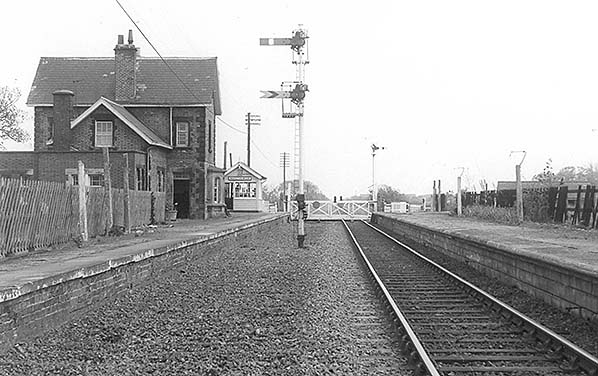 Looking east at Marston Moor in May 1973. The station is in remarkably good shape, 15 years after closure to passengers. The waiting shed on the former down (right) platform has been removed, but on the other platform the main building and gate box (recently downgraded from a signal box) are still in use, the former as a private residence. Lamp posts remain in place with their lantern cradles as do the nameboard stanchions on both platforms. The line has been singled, and a semaphore signal is re-positioned where the up track has been lifted. The upper ‘home’ protects Marston Moor level crossing and the lower ‘distant’ gives advance warning of Hessay crossing, a mile away.
Looking east at Marston Moor in May 1973. The station is in remarkably good shape, 15 years after closure to passengers. The waiting shed on the former down (right) platform has been removed, but on the other platform the main building and gate box (recently downgraded from a signal box) are still in use, the former as a private residence. Lamp posts remain in place with their lantern cradles as do the nameboard stanchions on both platforms. The line has been singled, and a semaphore signal is re-positioned where the up track has been lifted. The upper ‘home’ protects Marston Moor level crossing and the lower ‘distant’ gives advance warning of Hessay crossing, a mile away.
Photo
by John Mann
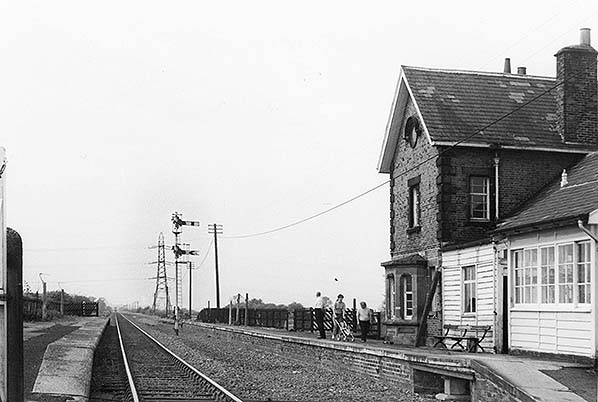 A general view of Marston Moor station in May 1973, looking north-west from the level crossing. The Poppleton to Hammerton stretch of the route through Marston Moor was changed from double- to single-track working on 4 June 1972 and the redundant rails serving the up platform had been recovered by May 1973. The Cattal-Knaresborough section was worked as a single line from 16 December 1973. The timber-built gate box (far right) was downgraded from a signal box when the line was singled. Both platforms are intact, 15 years after passenger trains ceased to call here, and the station building is in good order. Lamp standards, nameboard stanchions and a bench are still in place. The semaphore signals – upper ‘home’ protecting Marston Moor level crossing and lower ‘distant’ pertaining to Hessay level crossing, a mile away – have recently been placed on the former up trackbed. The identity of the people on the up platform is not known.
A general view of Marston Moor station in May 1973, looking north-west from the level crossing. The Poppleton to Hammerton stretch of the route through Marston Moor was changed from double- to single-track working on 4 June 1972 and the redundant rails serving the up platform had been recovered by May 1973. The Cattal-Knaresborough section was worked as a single line from 16 December 1973. The timber-built gate box (far right) was downgraded from a signal box when the line was singled. Both platforms are intact, 15 years after passenger trains ceased to call here, and the station building is in good order. Lamp standards, nameboard stanchions and a bench are still in place. The semaphore signals – upper ‘home’ protecting Marston Moor level crossing and lower ‘distant’ pertaining to Hessay level crossing, a mile away – have recently been placed on the former up trackbed. The identity of the people on the up platform is not known.
Photo
by John Mann
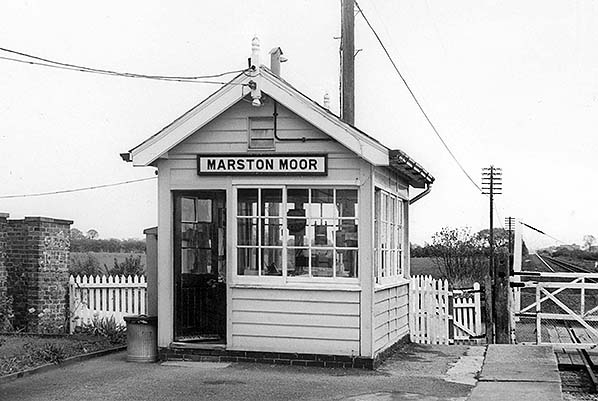 This signal box was built by the North Eastern Railway in 1910 to replace an exposed frame on the platform. In 1972, when the route was singled, it was demoted to serving only as a gate box. It is in immaculate condition, the nameplate recently re-painted in British Rail Corporate
This signal box was built by the North Eastern Railway in 1910 to replace an exposed frame on the platform. In 1972, when the route was singled, it was demoted to serving only as a gate box. It is in immaculate condition, the nameplate recently re-painted in British Rail Corporate
Identity black and white.
Photo
by John Mann
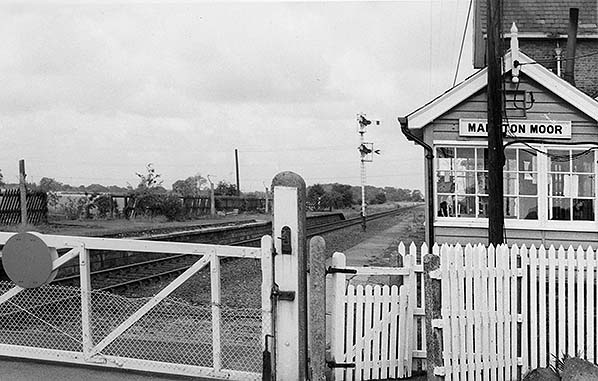 Marston Moor station, looking west from the level crossing in May 1973. The route through the station was changed from double- to single-line working on 4 June 1972, and by the date of this photograph the redundant up rails have been recovered, leaving the now bi-directional track next to the former down platform. In the foreground is the NER signal box constructed in 1910, which was downgraded to a gate box when single-line working began. Both platforms are largely intact, the down platform still equipped with a nameboard stanchion and lamps standards with lantern cradles. The gap in the fence is where the waiting shed once stood.
Marston Moor station, looking west from the level crossing in May 1973. The route through the station was changed from double- to single-line working on 4 June 1972, and by the date of this photograph the redundant up rails have been recovered, leaving the now bi-directional track next to the former down platform. In the foreground is the NER signal box constructed in 1910, which was downgraded to a gate box when single-line working began. Both platforms are largely intact, the down platform still equipped with a nameboard stanchion and lamps standards with lantern cradles. The gap in the fence is where the waiting shed once stood.
Photo
by John Mann
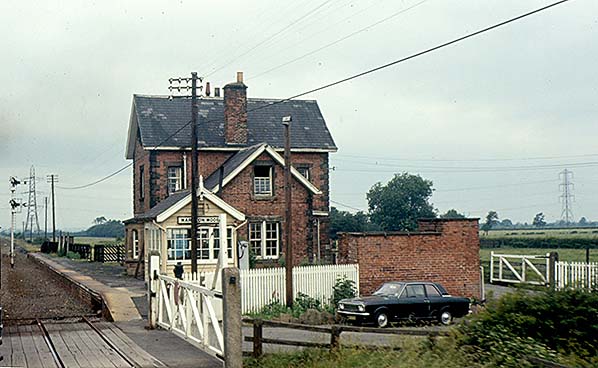 The former up platform at Marston Moor station is seen from a passing train on 29 June 1973. The platform is intact and the station building is in residential use. The gate box (with nameplate) and traditional crossing gate will be noted.
The former up platform at Marston Moor station is seen from a passing train on 29 June 1973. The platform is intact and the station building is in residential use. The gate box (with nameplate) and traditional crossing gate will be noted.
Photo
by Alan Young
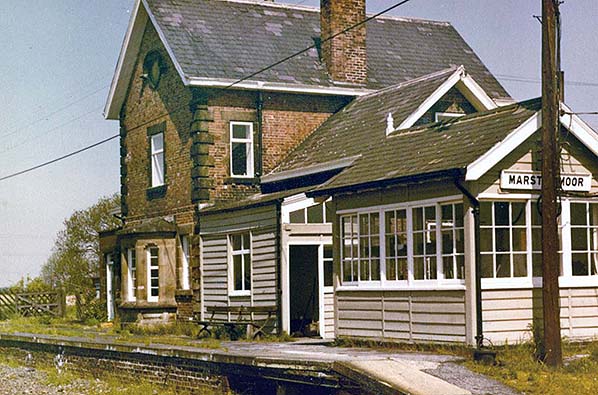 The gate box and station building at Marston Moor in 1977, looking north.
The gate box and station building at Marston Moor in 1977, looking north.
Photo
by Alan Lewis from his Ipernity photo gallery
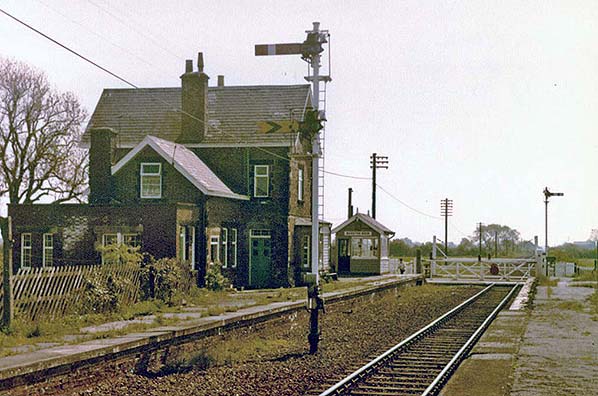 Marston Moor station looking east from the former down platform in 1977. The up platform is on the left and the station building and gate box are in situ, the former in residential use and the latter still housing the frame from which the signals are operated and the crossing gates are locked. The signal post in the foreground is on the site of the up line which was redundant, and subsequently removed, after single-line working was introduced in 1972. The upper (home) signal protects this level crossing, and the lower (distant) pertains to Hessay level crossing a mile ahead.
Marston Moor station looking east from the former down platform in 1977. The up platform is on the left and the station building and gate box are in situ, the former in residential use and the latter still housing the frame from which the signals are operated and the crossing gates are locked. The signal post in the foreground is on the site of the up line which was redundant, and subsequently removed, after single-line working was introduced in 1972. The upper (home) signal protects this level crossing, and the lower (distant) pertains to Hessay level crossing a mile ahead.
Photo
by Alan Lewis from his Ipernity photo gallery
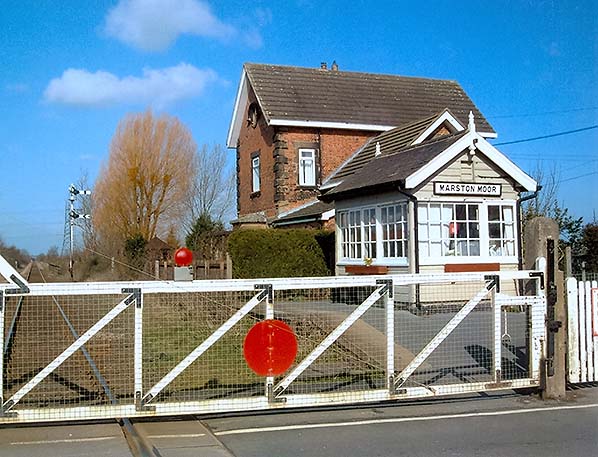 Marston Moor station looking west from the level crossing in March 2008. The old up platform is in place, and the station building and gate box are still in use, the former as a private residence. For many years the railway has been operated as a single track.
Marston Moor station looking west from the level crossing in March 2008. The old up platform is in place, and the station building and gate box are still in use, the former as a private residence. For many years the railway has been operated as a single track.
Photo
by Alan Young
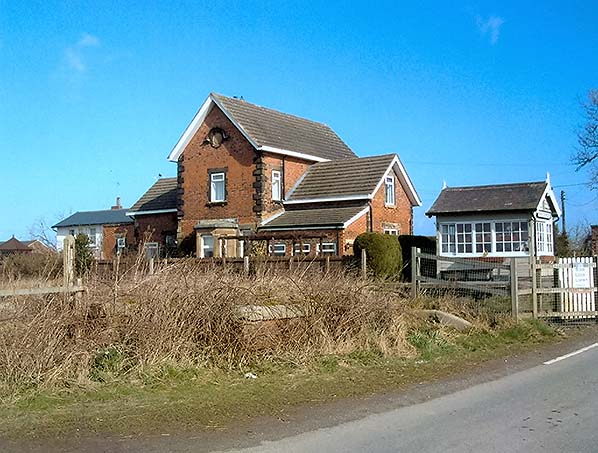 Looking north at the station building and gate box of Marston Moor in March 2008. The brick structure in the foreground was part of the station’s long disused coal depot. The former Union Tavern can be seen to the left of the station building.
Looking north at the station building and gate box of Marston Moor in March 2008. The brick structure in the foreground was part of the station’s long disused coal depot. The former Union Tavern can be seen to the left of the station building.
Photo
by Alan Young
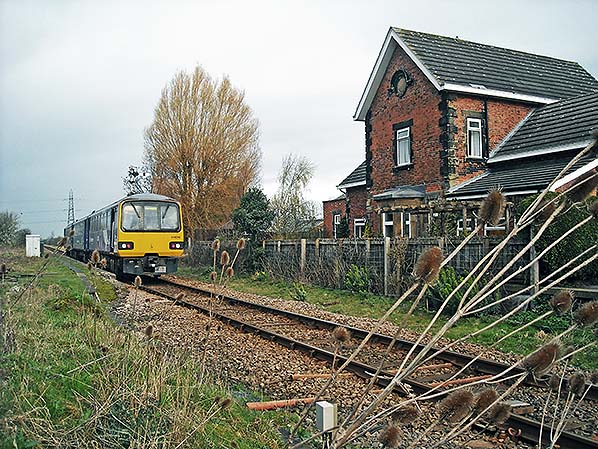 On 5 April 2014 a Harrogate-bound train (144 016) is speeding past the remains of Marston Moor station’s down platform on the single line. The building dates from the opening of line in 1848 and is of a design seen also at the neighbouring Hopperton, Cattal and Poppleton stations.
On 5 April 2014 a Harrogate-bound train (144 016) is speeding past the remains of Marston Moor station’s down platform on the single line. The building dates from the opening of line in 1848 and is of a design seen also at the neighbouring Hopperton, Cattal and Poppleton stations.
Photo
by Alan Young
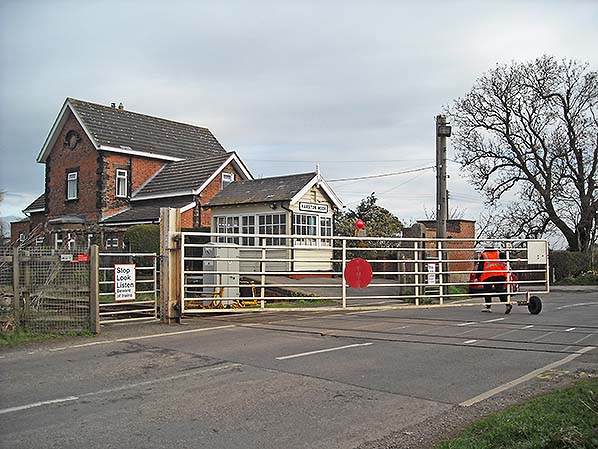 The disused Marston Moor station on the York – Harrogate line is seen in April 2014. By this time manually-operated crossing gates on public roads are an endangered species, but several survive on this route. The gatekeeper, Ivy Boulton, is wheeling the gate open. Signals to protect the crossing are still operated from the gate box.
The disused Marston Moor station on the York – Harrogate line is seen in April 2014. By this time manually-operated crossing gates on public roads are an endangered species, but several survive on this route. The gatekeeper, Ivy Boulton, is wheeling the gate open. Signals to protect the crossing are still operated from the gate box.
Photo
by Alan Young
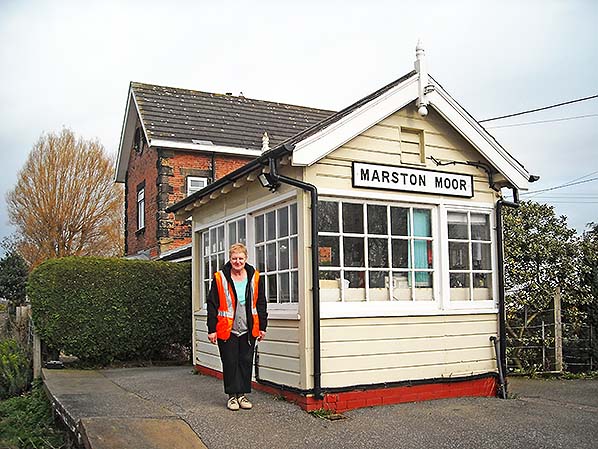 Ivy Boulton, photographed in April 2014 on the old up platform, has worked on the York-Harrogate route since 1978 and been gatekeeper at Marston Moor since 1982; her husband performs the same duty at a crossing on the York–Scarborough line. The immaculate condition of the Grade II listed gate box is apparent, and the former station building, partly obscured by the hedge, is also carefully maintained as a private residence.
Ivy Boulton, photographed in April 2014 on the old up platform, has worked on the York-Harrogate route since 1978 and been gatekeeper at Marston Moor since 1982; her husband performs the same duty at a crossing on the York–Scarborough line. The immaculate condition of the Grade II listed gate box is apparent, and the former station building, partly obscured by the hedge, is also carefully maintained as a private residence.
Photo
by Alan Young
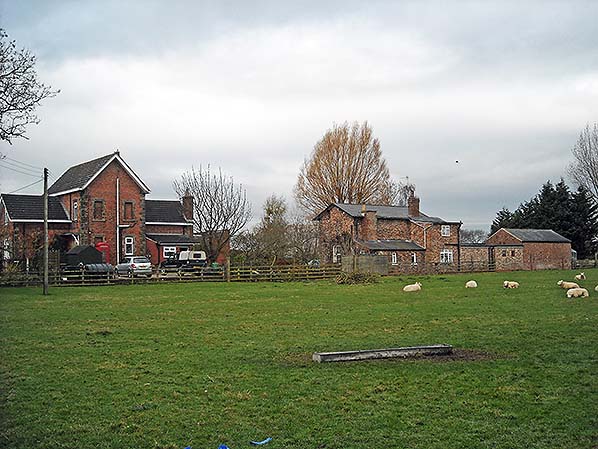 The station building at Marston Moor is seen left in this view looking south-west in April 2014; the station closed to passengers in 1958 and to goods in 1965. The former Union Tavern is to the right.
The station building at Marston Moor is seen left in this view looking south-west in April 2014; the station closed to passengers in 1958 and to goods in 1965. The former Union Tavern is to the right.
Photo
by Alan Young
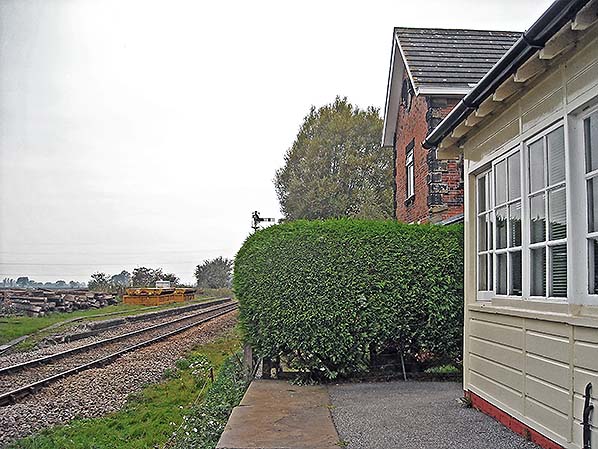 Looking west from the old up platform of Marston Moor station in September 2014. To the right are the gate box and station building, and to the left are the remains of the down platform. The York-Harrogate line remains open, with an hourly weekday service in each direction and regular Sunday trains; this is a great improvement on the frequency of trains in 1958 when Marston Moor closed to passengers. The ‘home’ semaphore signal, seen above the hedge, protects the level crossing (behind the camera).
Looking west from the old up platform of Marston Moor station in September 2014. To the right are the gate box and station building, and to the left are the remains of the down platform. The York-Harrogate line remains open, with an hourly weekday service in each direction and regular Sunday trains; this is a great improvement on the frequency of trains in 1958 when Marston Moor closed to passengers. The ‘home’ semaphore signal, seen above the hedge, protects the level crossing (behind the camera).
Photo
by Alan Young
Click on thumbnail to enlarge

